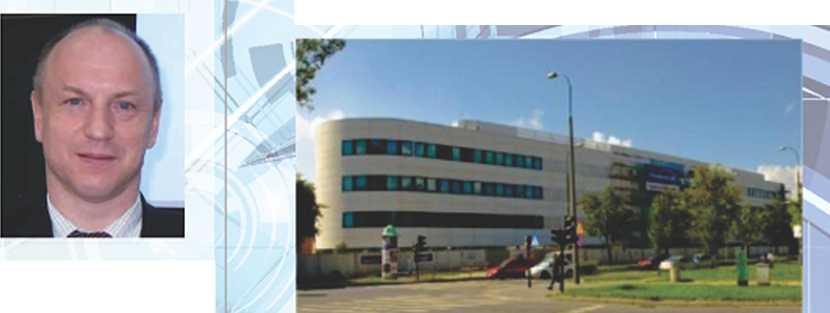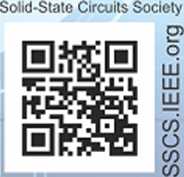4917953755
|
1 | |
|
”1 |
1/J |

IEEE Solid-State Circuits Society Poland Chapter
invites for

AGH
Lecture / Keynote talk
by Prof. Robert Staszewski (University College, Dublin)
It is Time to use Time
for Digital
RF Clock Generation
Wednesday, June 15th, 2016, 11:30, Building D-17
During EBCCSP2016 conference
. A, ALL STUDENTS

ARE WELCOME
ATTENDANCE FREE OF CHARGE
Unlike today when “digital turns into analog” and “analog turns into digital”, back in the late 1990s, the separation between analog and digital was unmistakable and vast. The design techniques, automation flow (or the lack of it), or even the way of designers’ thinking were simply incompatible. Probably the only major area that was blurring these boundaries was a read channel for magnetic recording in hard disk drives. It employed precise continuous-time filtering combined with ultra-high speed discrete time analog signal Processing plus sophisticated digital Processing. Having been fully immersed in that way of thinking and then moving to an RF group within Texas Instruments has produced an eye-opening experience. The read channel was sampling at 750MS/S and GSM then was only 900MHz so the CMOS technology was becoming fast enough. Why not exploit the digital and sampling techniques to directly digitize the RF signal? Of course doing so blindly would burn too much power to make it practical but why not exploit.another idea of magnetic recording: time-domairytaformation? The information has traditionally been encoded as voltage (or sometimes current), but why not use time? This immediately led to the idea of time-to-digital converters (TDC) to solye the pesky problem of phase error filtering in PLLs. When a digitally controlled oscillator (DCO)-Was added to it, the resblting ADPLL is jUst the history.
' VenuJr

W
Venuj
AGH University of Science and Technology Av. Mickiewicza 30, Kraków, Poland Building D-17 (Department of Computer Science) Kawiory 21

Biography of the irtyited speaker
R. Bogdan Staszewski received BSEE (dumma cum laude), MSEE and PhD from University of Texas at Dallas, USA, in 1991, 1992 and 2002, respectively.
N
From 1991 to 1995 he was with Alcatel in Richardson,
Texas. He joined Texas Instruments in Dallas, Texas in 1995. In 1999 he co-started a Digital RF Processor (DRP) group in TI with a mission to invent new digitally intensive approaches to traditional RF functions. Dr.

Second International Conference on Event-Based Control, Communication and Signal Processing EBCCSP 2016
ebccsp2016.org
Staszewski served as a CTO of the DRP group between 2007 and 2009. In July 2009 he joined Delft University of Technology in the Netherlands where he is currently a part-time-Fuli Professor. Since Sept. 2014 he is a Professor at University College Dublin (UCD) in Ireland. He has co-authored two books, four book chapters, 200 journal and conference publications, and holds 150 issued US patents. His research interests include nanoscale CMOS architectures and circuits for frequency synthesizers, transmitters and receivers. He is an IEEE Fellow and a recipient of IEEE Circuits and Systems Industrial Pioneer Award (http://ieee-cas.org/about/awards/industrial-pioneer-award).
Wyszukiwarka
Podobne podstrony:
r❖i ^ UJ AGH IEEE Solid-State Circuits Society Poland Chapter invites for Lectu re by Prof. Edoardo
IEEE Solid-State Circuits Society Poland Chapter together with Department of Measurement and
IEEE Solid-State Circuits Society Poland Chapter together with Department of Measurement and
A♦IEEEInvited Lectures by Prof. Willy Sansen organized by the IEEE Solid-State Circuits Society Pola
iiIEEE Solid-State Circuits Society Poland Chapter together with Department of Measurement and
Uf AGH IEEE Solid-State Circuits Society Chapter Poland together with Department of
DL Willy Sansen Yisits SSCS Poland Chapter The IEEE Solid-State Circuits Soci-ety (SSCS) Poland Chap
4IEEE { lilii V.V AGHInvited Lectures by Prof. Bogdan Staszewski organized by the IEEE Solid-State
READING Multiple choiceTOPIĆ State and society EXAM TIPS ► With multiple choice
11 WRITING Discursive essaysTOPIĆ State and society EXAM TIPS ► Read the EXAM TASK
gonsoi.es Collins IC Console Series The Collins IC-10 and IC-6 all solid State consoles offer the br
Moseley PCL-303 Transmitter The all solid State PCL-303 STL Transmitter uses the direct FM system. F
settings default state Preferences Behaviour Number format Default State I~1 Remember last State Num
CFA Society Poland JAKIE SĄ POTRZEBY I ZWYCZAJE INWESTYCYJNE MILLENIALSÓW? ■
-. 1996. The State Against Society. Political Crises and their Aftermath in East Central Europę, Pri
Snhmitted: 2014-12-12 Reeised: 2015-04-22 Accepted: 2015-04-22 Online: 2015-08-28 Solid State
Solid State Phenomena Submitted2016-02-19 Accepted: 2016-02-03 Online: 2016-07-20 ISSN: 1662-97
Karta projektu (Project Charter) a a m POLAND CHAPTER Karta projektu (Project Charter) jest zazwycza
więcej podobnych podstron